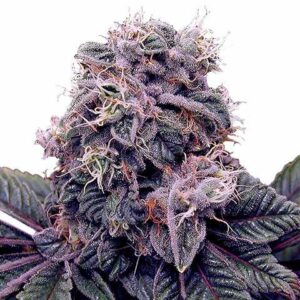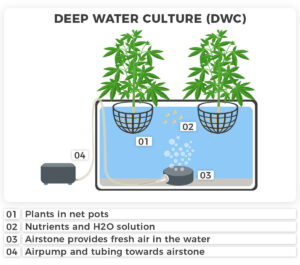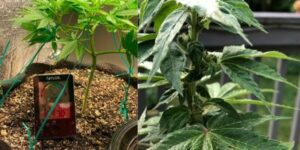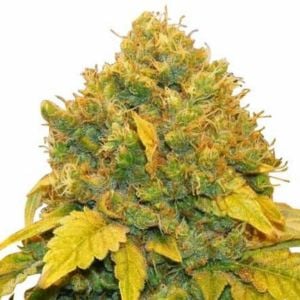When you start cultivating cannabis indoors, whether the beginning of a lifetime endeavor or a seasonal hobby, there are many initial hurdles to overcome to give your plants the environment they need to thrive. Knowing where to start can be a challenge. Advice on building an indoor grow depends on your techniques and setup, but most importantly, it depends on your grow location.
In this article, we’ll review the ins and outs of cultivating an attic or loft grow room to ensure you know everything needed before starting. Some homes and living situations don’t include an attic or loft, but when they do, the space can be perfect for setting up an out-of-the-way and secure grow. It can be tempting to rush into your first grow once you’ve found unused space in your attic, but a little caution and planning before your attic grow room is built will reduce stress down the road.
The specifics of growing weed in an attic
In cannabis cultivation, so much depends on your environmental variables and the grow location. In some homes, the attic may go unused and could be the perfect hideaway spot to put a few cannabis plants where they won’t interfere with daily life.
That being said, in general, growing cannabis in the attic will require cultivation knowledge outlined in our Grow Bible. This article will examine the exceptions and specifics of an attic grow room to ensure your horticultural efforts succeed. When you know how to set up a low-budget grow room, you can keep things at a low cost and relatively simple or go all out and automate your attic grows.
Can I grow in the attic?
Of course! The attic, if available, can be used to cultivate like most other open areas and closets in your home. Plants can be left alone easier up in an attic where only the grower may interfere and know about them. It may even provide enough space for a fairly large grow that cannot fit elsewhere in your home.
The attic is often forgotten and used to store old items and decorations. Building a grow room in an attic is the perfect way to utilize your space and keep it from getting dusty and forgotten while conveniently staying near your plants and ensuring others cannot access them.
The pros and cons of growing cannabis in an attic
We’ve established that the attic could be a great place to grow cannabis, but let’s break it down here.
The pros of using your attic:
- It utilizes unused spaces in the home, keeps your grow nearby and ready to tend, and can be hidden from guests and other people in the house if needed. Your attic grow room can be as simple as a small grow tent and scale up from there.
- The attic is a low-cost entry option for a grower to experiment with cultivation on a small scale. Experienced growers can turn an attic into a perpetual grow by using exposed studs, floor joists, and more to construct the grow room of their dreams.
The cons of using your attic:
- Accessing your grow in the attic can be challenging. For example, in my home growing up, a three-part folding ladder needed to be pulled down from the garage ceiling to reach the attic. This can wreck the convenience factor for you and add to the struggle of home growing.
- The other major issue in an attic is temperature control, depending on your home and situation. Most homes have an insulation layer on the attic floor to keep the rooms below at the correct temperature. This means the attic is swinging in temperature with the outdoors and is not environmentally controlled. If you have good weather, the attic will be temperate, but your plants will experience outside temps even when it’s cold or hot outside.
- Flooring stability and utility access can also be questionable in attics, not to mention the varying ceiling height some attics introduce to the situation.


Shop Indoor Seeds
- Indoor-thriving plants
- For windowsill or under lamps
- Feminized and autoflowers seeds
Things to consider when starting an attic grow room
The cons listed above are the first things to keep in mind when constructing an attic grow. The accessibility of the attic, the stability of the flooring in the attic, the insulation or lack thereof in the attic, and utilities access are the big four that come next. This is before potential height constraints due to sloping roofs.
If you live in an area with heavy snow and ice in the winter, you may want to consider that your grow will most likely heat up a patch of your roof and melt said snow and ice. A friend of mine had this happen in Minneapolis, Minnesota and had to take his grow down to maintain privacy. Driving home and realizing every house is snow-covered, but yours is definitely a concern.
However, it’s the opposite problem in the desert, with attic temps rising to over 100 degrees and higher on hot days.
Potential dangers of growing in the attic
There are unique dangers to remember when cultivating in an attic; the first is the flooring. Many attics have no flooring. Do not set up an attic grow, thinking you will hop across the ceiling beams. A fall or slip can send you through the ceiling of your house into the room below, which may be a minor sheetrock repair or a major trip to the hospital. Consider installing proper flooring to support you and your attic grow room equipment.
Next would be the potential for leaking and spills. These are not wanted in any grow setup but are particularly dangerous in an attic since home wiring and electricity can be run through the ceilings. If water is spilled or leaked in the attic, it can cause electrical issues or contribute to mold and other structural issues that homeowners want nothing to do with.
In other words, the attic was not designed to handle water and humidity. Plan accordingly by setting redundant safety measures like a tarp under the grow tent to make 100% sure you aren’t impacting the structural or electrical integrity of your home while growing.
Fire is always a danger to be aware of when cultivating anywhere. It’s also true in an attic. When building a grow room in an attic, choose the right equipment. Pay careful attention to grow lights. They generate additional heat, making it harder for your grow room to reach its target temps. You can use air-cooled lights and, in general, equipment with low heat output and optional safety features to shut down in case of overheating to get around this.
You don’t want to introduce sparks or additional heat in the attic surrounded by your home’s wood framing and insulation. Be smart. The reality is certain attics are just not safe for cultivation, especially those with loose insulation, no flooring, and limited headspace.
Climate control issues specific to attic grows
With the dangers accounted for, we can discuss the next challenge in attic grow rooms: climate control!
Homes are built to control the environment within the home; this rarely includes the attic. Most heat generated in the attic will rise and be lost through the uninsulated roof, and the attic will be stuffy and hot when the sun is high. This can create a range of different climate-related problems.
You can address this. First of all, reduce the space you have to environmentally control by growing in a tent. If you want an open room concept in your attic, you’ll need a higher budget and insulation (see below). Heaters can help with the cooler temps, while fans and air ventilation can assist in the heat.
You can also try pulling air into the attic grow/tent from the home and not the outdoors. This may require some light HVAC work and creativity, but pulling the air from your home will give your plants a source of fresh air that is much closer to your target temps. Air pulled from within the home is also richer in CO2 (thanks to our exhalations), supplementing the environment in your attic grow naturally.
Your ventilation out of the grow should intake air from outside. Do this stealthily by running it under the eaves of your home where it isn’t visible from the outside.
The last thing to note and recommend is an environmental controller. Sure, you can grow without closely monitoring your grows, but the location and unique situation of growing in an attic really make environmental controls preferable. Being able to look at a controller or app on your phone for quick peace of mind will save you many trips to the attic and potentially save your grow or home if disaster strikes.


Should you insulate your attic when you want to use it as a grow room?
This is a difficult question to answer without knowing your cultivating goals and unique attic setup. Basically, it is not required, but it is generally a good idea. If you can insulate the attic, it will almost always be worth the effort.
Having temperature and humidity under your control is the name of the game in indoor cultivation. Growing in uninsulated places just makes that harder. You can use insulation boards or a myriad of other ways to formally and legitimately insulate your attic. Install proper flooring while you’re at it.
At a minimum, consider insulating part of the attic by creating a more controlled space within it. That process is more like building your own grow tent once you choose the space.
For those on a budget, growing in a tent placed in the attic accomplishes the same goal of creating a smaller space. If you have the luxury of a huge attic, you should insulate. Those lucky enough to have large attics could set up a top-of-the-line grow with the right tech and budget. Those with small and constrained attic spaces should be creative but always keep fire and water risks in mind.
Mistakes to avoid when growing marijuana in the attic
Don’t fall through the ceiling, and don’t melt the snow and ice off your roof in the winter. But seriously, be careful when growing in the attic; it introduces a lot of failure points that don’t exist when growing somewhere else, like a spare room or the basement.
You also want to avoid running your electrical off an extension cord running back into the house. Don’t do this. Contact an electrician to install a proper power supply to your attic safely. If you already have a power outlet in the attic, it may still be worth having somebody test it, as attics tend to get dusty and forgotten over the years. If you do this initially, you’ll be off to the races cultivating in your attic grow with much less stress. Remember, an ounce of prevention is a pound of cure.
With all of the previously mentioned notes and suggestions in mind, we can talk about watering and cultivar selections when building a grow room in an attic. Hydro and automated watering systems are great in the attic because you can rely on the system.
That being said, have your redundancies in place and keep small water reservoirs in safe places like plastic tubes where leaks will not affect the attic or your home. If you can swing it, having a water connection run up from the house into the attic would be ideal, but in most cases, you’ll be carrying water for the grow upstairs.
Plan this out; water is heavy and can throw you off balance when climbing a ladder to the attic. Consider a pulley system or a small amount of rigging to move things up and down quicker if this is a permanent space for you.
When selecting cultivars, it’s always important to consider your space; it rings true again for the attic. You do not want to be stuck with a leggy sativa landrace reaching for the stars in the attic when you have a limited headspace of five feet. That will be an unhappy plant, for sure.
Choose cultivars that will match the profile of your grow. If you want that leggy sativa, employ low-stress or high-stress training to shape and nurture the plant into the shape and size you need to achieve your goals and stay within your constraints.
Need some inspiration? We have a wonderful lineup of seeds to select from at ILGM.
Noise may also be a concern for the attic, depending on which rooms of the house your grow is on top of; ventilation fans, pumps, and heaters may all add a certain “white noise” vibe. If this is too noticeable, you may be able to find some stealthier equipment options or consider insulation, as it will mask some of the sound.
Grow tents specially made for your attic grow
Let’s talk about using grow tents in an attic grow room build. You could grab a micro grow box or a 2×2 tent and run something small. Micro grows will reduce the stress around the flooring, insulation, and more. In general, a micro grow box is a great place to get started and stay stealthy.
But if you’d like to really maximize the space, you’d go taller. However, the ceilings of attics are not exactly easy to work with; some have a sloped roof, limiting the amount of full space available. Luckily, grow equipment companies are now making grow tents with this attic shape in mind.
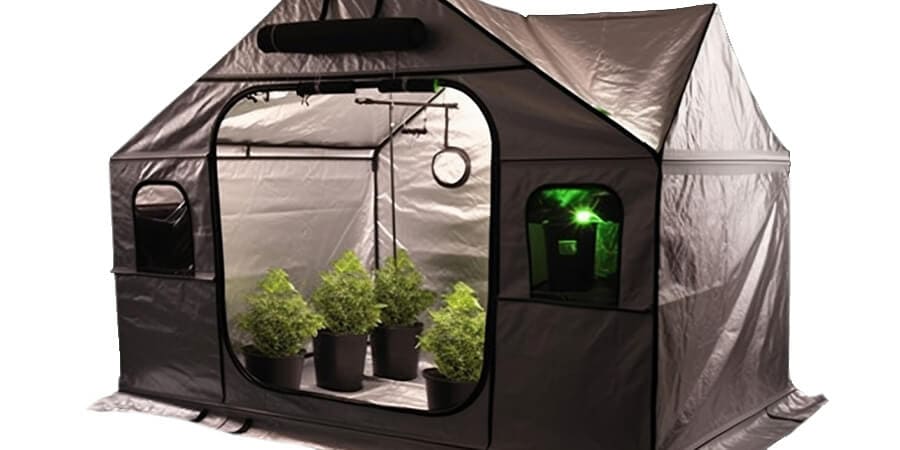

These tents help solve some of the insulation, temperature, and water leakage concerns by containing your grow and giving you as much height as you need in the center while accommodating sloping roofs. Here’s one example of a ‘loft grow tent’; it gives you more room for hanging equipment and more space for air ducts, fans, and lights.
You could also start with a grow tent, then kit out your attic to support that sized tent to avoid over-insulating and retooling your attic space. This can also help visualize the needed ventilation and even test the temperature swings before starting.
Final thoughts:
In summary, an attic grow room has serious potential for home cultivating, but there are a whole lot of concerns and issues to go with it.
If you are lucky to have an environmentally controlled attic, then by all means, it is the perfect spot to grow. But if you have an unfloored attic that is full of insulation, your work may be cut out for you to prep the space.
I personally would prefer to grow in locations I can reach without climbing a ladder and not worry about structural and electrical issues due to my attic. But I definitely see the value and the security provided by attic grows; they can be extremely stealthy if needed. If you have the space to try an attic grow, consider the pros and cons and weigh them against growing in your basement or spare bathroom/bedroom before digging in.
Cannabis can thrive where you want it to with the right care and attention to detail. Remember, cultivation involves continuous learning and incremental improvements; the only way to start that journey is to pop some seeds and give it a try.
Want to do more research first? Sign up for our Grow Bible and review our extensive library of articles anytime you have a question. If you have any stories about your attic grows or comments on best practices when cultivating in an attic, add them below.
Keep on growing!
- SEO Powered Content & PR Distribution. Get Amplified Today.
- PlatoData.Network Vertical Generative Ai. Empower Yourself. Access Here.
- PlatoAiStream. Web3 Intelligence. Knowledge Amplified. Access Here.
- PlatoESG. Carbon, CleanTech, Energy, Environment, Solar, Waste Management. Access Here.
- PlatoHealth. Biotech and Clinical Trials Intelligence. Access Here.
- Source: https://www.ilovegrowingmarijuana.com/growing/indoors/room/attic-grow-room/
- :has
- :is
- :not
- :where
- $UP
- 1
- 100
- 300
- a
- Able
- About
- above
- access
- accessibility
- accordingly
- accounted
- Achieve
- across
- add
- Additional
- address
- advice
- affect
- again
- against
- AIR
- All
- almost
- alone
- already
- also
- always
- amount
- an
- and
- answer
- any
- anywhere
- app
- ARE
- AREA
- areas
- around
- article
- articles
- AS
- assist
- At
- attention
- automate
- Automated
- available
- avoid
- aware
- back
- Balance
- Basically
- BE
- because
- before
- Beginning
- being
- below
- BEST
- best practices
- Big
- Box
- Break
- budget
- build
- Building
- built
- but
- by
- CAN
- cannabis
- cannot
- care
- careful
- carrying
- case
- cases
- Cause
- caution
- ceiling
- Center
- certain
- challenge
- challenging
- Choose
- Climate
- Climbing
- closely
- closer
- co2
- cold
- come
- comments
- Companies
- concept
- Concern
- Concerns
- connection
- Cons
- Consider
- constraints
- construct
- constructing
- contact
- continuous
- contribute
- control
- controlled
- controller
- controls
- convenience
- correct
- Cost
- could
- create
- Creating
- Creative
- creativity
- Cultivate
- cultivation
- cure
- Cut
- daily
- DANGER
- Dangerous
- dangers
- Days
- definitely
- Depending
- depends
- DESERT
- designed
- detail
- different
- difficult
- disaster
- discuss
- do
- Dont
- down
- dreams
- driving
- due
- easier
- easy
- effort
- efforts
- electricity
- else
- elsewhere
- endeavor
- enough
- ensure
- ensuring
- entry
- Environment
- environmental
- environmentally
- equipment
- especially
- established
- Even
- Every
- everything
- exactly
- examine
- example
- exist
- experience
- experienced
- experiment
- exposed
- extension
- extensive
- extremely
- factor
- Failure
- fairly
- Fall
- fans
- Features
- Feet
- few
- Find
- Fire
- First
- fit
- five
- Floor
- For
- forgotten
- Formally
- found
- four
- fresh
- friend
- from
- full
- game
- garage
- General
- generally
- generate
- generated
- get
- getting
- Give
- gives
- Giving
- Go
- goal
- Goals
- good
- grab
- great
- Grow
- growers
- Growing
- Grows
- guests
- had
- hand
- handle
- happen
- harder
- Have
- having
- heavy
- height
- help
- here
- Hidden
- High
- higher
- his
- Home
- Homes
- Hospital
- HOT
- House
- How
- How To
- However
- HTTPS
- huge
- Hurdles
- hvac
- i
- ICE
- idea
- ideal
- if
- impacting
- important
- improvements
- in
- include
- includes
- Indoor
- initial
- initially
- Inspiration
- install
- installing
- integrity
- interfere
- into
- introduce
- Introduces
- involves
- issue
- issues
- IT
- items
- ITS
- journey
- jpg
- just
- Keep
- kit
- Know
- Knowing
- knowledge
- Lack
- ladder
- large
- Last
- layer
- Leaks
- learning
- left
- less
- Library
- Life
- lifetime
- light
- like
- likely
- Limited
- lineup
- Listed
- little
- live
- living
- location
- locations
- Look
- lost
- Lot
- Low
- low-cost
- luckily
- Luxury
- made
- maintain
- major
- make
- MAKES
- Making
- many
- marijuana
- mask
- Match
- max-width
- Maximize
- May..
- means
- measures
- mention
- mentioned
- micro
- mind
- mine
- minimum
- minnesota
- minor
- monitoring
- more
- most
- move
- much
- my
- myriad
- name
- Near
- Need
- needed
- next
- no
- note
- Notes
- nothing
- now
- nurture
- of
- off
- often
- Old
- on
- once
- ONE
- only
- open
- opposite
- Option
- Options
- or
- Other
- Others
- our
- out
- outdoors
- outlet
- outlined
- output
- outside
- over
- Overcome
- own
- part
- particularly
- Patch
- Pay
- peace
- People
- perfect
- permanent
- Perpetual
- Personally
- phone
- Place
- placed
- Places
- plan
- planning
- plant
- plants
- plastic
- plato
- Plato Data Intelligence
- PlatoData
- points
- pop
- potential
- potentially
- pound
- power
- Power Supply
- practices
- prefer
- preferable
- Prevention
- previously
- privacy
- Problem
- problems
- process
- Profile
- proper
- PROS
- provide
- provided
- pulling
- pumps
- put
- question
- Quick
- quicker
- range
- rarely
- reach
- reaching
- ready
- Reality
- realizing
- really
- recommend
- reduce
- relatively
- rely
- remember
- repair
- require
- required
- research
- review
- right
- Rise
- rising
- risks
- road
- roof
- Room
- Rooms
- Run
- running
- rush
- safe
- safely
- Safety
- Said
- same
- Save
- Scale
- seasonal
- secure
- security
- see
- seeds
- selecting
- send
- serious
- seriously
- set
- setting
- setup
- Shape
- should
- Shut down
- sign
- Simple
- since
- situation
- situations
- Size
- sized
- small
- smaller
- smart
- snow
- So
- SOLVE
- some
- something
- somewhere
- Sound
- Source
- Space
- spaces
- Sparks
- specially
- specific
- specifics
- Spot
- Stability
- Stars
- start
- started
- Starting
- stay
- staying
- stealthy
- Still
- store
- Stories
- stress
- Strikes
- structural
- Struggle
- succeed
- SUMMARY
- Sun
- supply
- support
- sure
- surrounded
- Swing
- Swings
- system
- Systems
- Take
- Talk
- Target
- tech
- techniques
- tent
- test
- thanks
- that
- The
- their
- Them
- then
- There.
- These
- they
- thing
- things
- Thinking
- this
- those
- Thrive
- Through
- tips
- Title
- to
- too
- top
- trip
- true
- try
- TURN
- under
- unique
- unused
- upstairs
- use
- used
- using
- utilities
- utility
- utilize
- utilizes
- value
- varying
- Vibe
- visible
- visualize
- want
- wanted
- was
- Water
- watering
- Way..
- ways
- we
- Weather
- weed
- weigh
- when
- whether
- which
- while
- whole
- will
- Winter
- with
- within
- without
- wonderful
- wood
- words
- Work
- worry
- worth
- would
- years
- you
- Your
- zephyrnet



